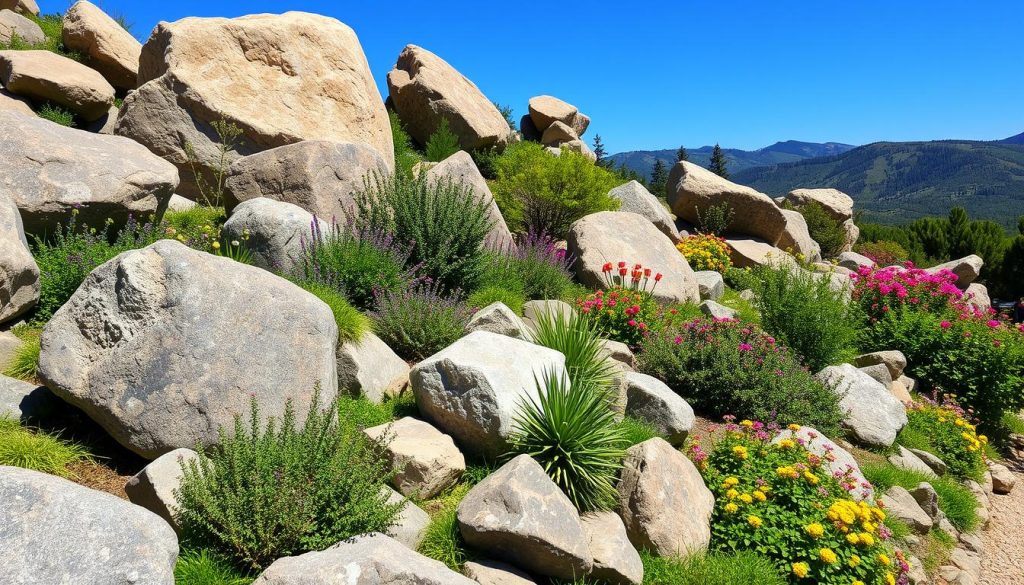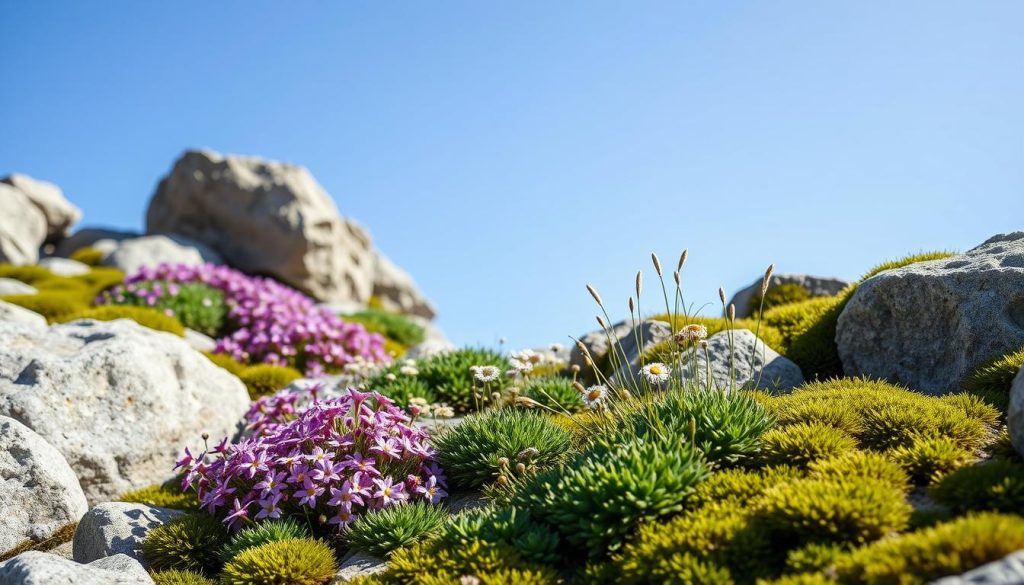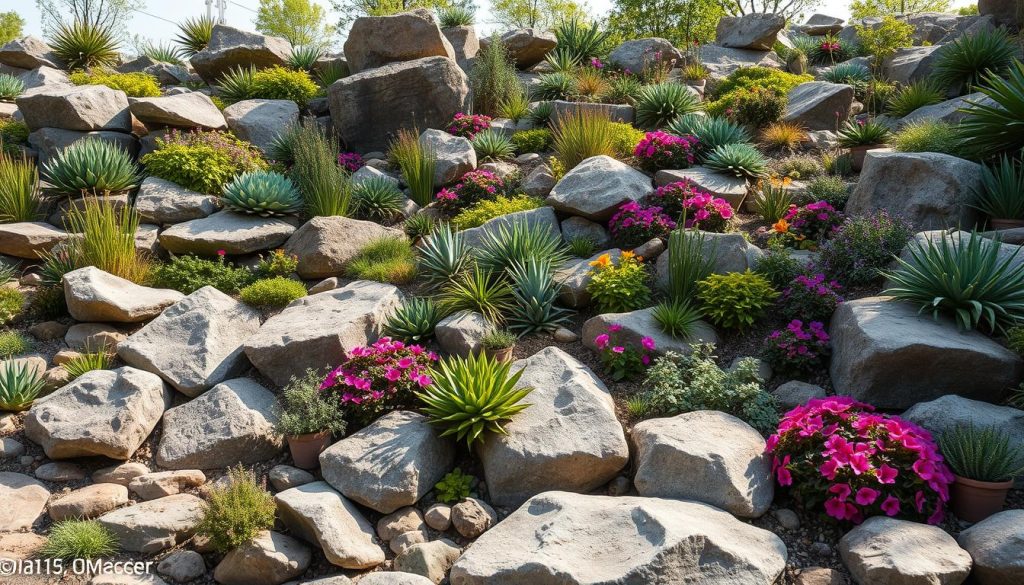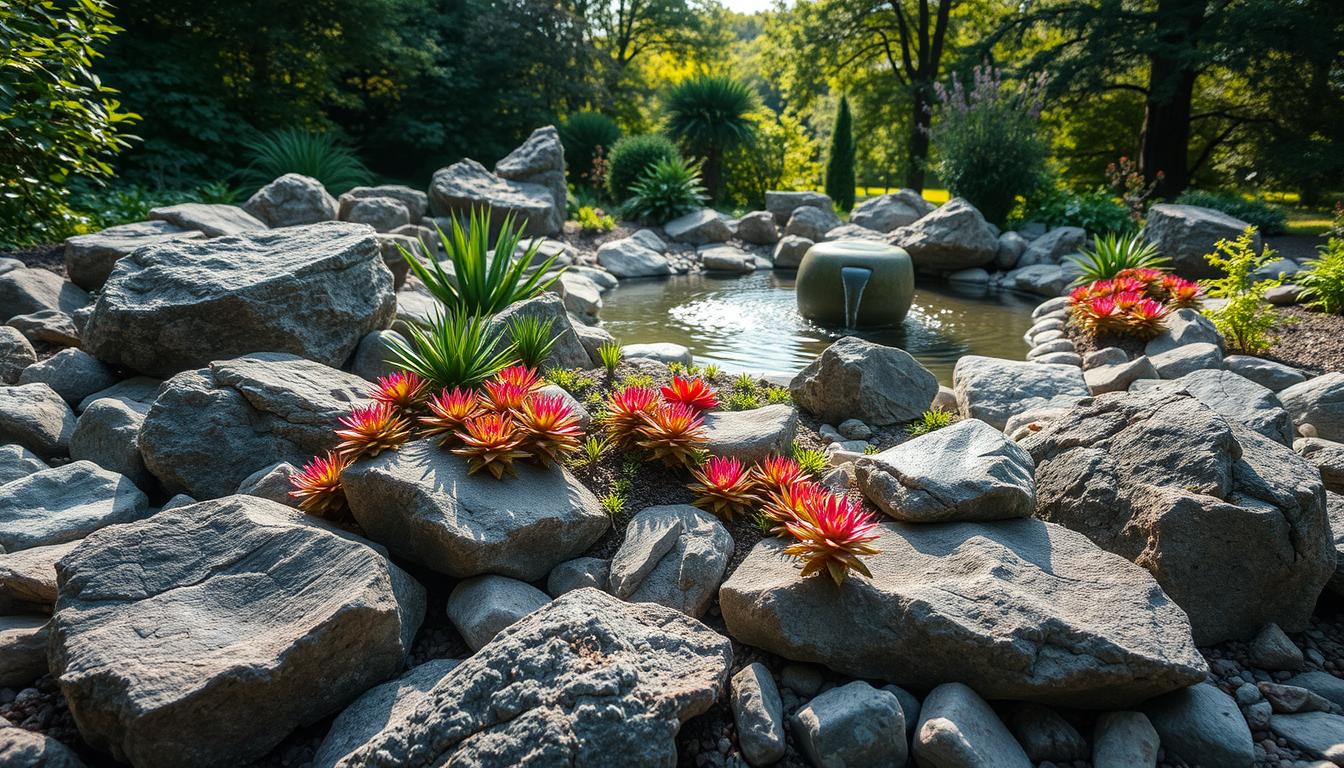I’m excited to explore rock garden design ideas with you. These natural wonders combine beauty with low-maintenance landscaping. If you want to change your yard, a rock garden could be the answer.
Rock gardens can make dull areas into beautiful landscapes. It’s more than just placing stones. It’s an art that mixes rocks, plants, and design for a stunning outdoor space.
In this guide, we’ll look at different rock garden designs. We’ll see how to make a space that looks great and is easy to care for. Whether your space is small or big, there’s a design for you.
Let’s start this journey to make your outdoor space a low-maintenance oasis. Get ready to be inspired by the beauty and simplicity of rock gardens!
Understanding the Basics of Rock Garden Design
Rock gardens add charm to outdoor spaces. They mix nature with plants in a special way. Let’s dive into what makes them unique and why they’re great for yards.
What is a Rock Garden?
A rock garden uses rocks, gravel, and plants that don’t need much water. It looks like a natural rocky area. It brings rugged beauty to homes.
Key Features of Rock Gardens
The main parts of a rock garden are:
- Strategically placed rocks and boulders
- Well-draining soil mixed with gravel
- Drought-tolerant plants that thrive in rocky conditions
- Xeriscaping principles for water conservation
Benefits of Incorporating Rock Gardens
Rock gardens have many benefits:
- Low maintenance requirements
- Water efficiency through xeriscaping techniques
- Ability to thrive in challenging landscapes
- Year-round visual interest
- Habitat for beneficial insects and small wildlife
Knowing these basics helps me plan my own rock garden. It’s a fun way to make a sustainable, beautiful outdoor space. It’s different from regular lawns and flowerbeds.
Choosing the Right Location for My Rock Garden
Finding the perfect spot for my rock garden is crucial. I must think about several things to make sure it looks great and grows well.
Evaluating Sunlight and Shade
I watch how sunlight changes in my yard. Most plants like full sun, but some can handle partial shade. I mark sunny and shady spots to plan where to put my plants.

| Area | Morning Sun | Midday Sun | Afternoon Sun |
|---|---|---|---|
| Front Yard | Full | Full | Partial |
| Side Yard | Partial | Full | Full |
| Backyard | Shade | Partial | Full |
Considering Drainage and Soil Type
Drainage is key for rock gardens. I dig a hole, fill it with water, and see how fast it drains. If water stays too long, I’ll need to fix the drainage.
I also check my soil. Rocky or sandy soil is best for rock gardens. If my soil is clay, I’ll mix in sand and gravel to help it drain better. For sloped areas, I might use terraces or walls to stop erosion and make planting easier.
By looking at these factors, I can pick the best place for my rock garden. This will help it become a beautiful and thriving part of my yard.
Selecting the Perfect Rocks for My Garden
Choosing the right rocks is key for a stunning rock garden. Rock garden construction techniques are important for a natural look. Let’s look at the types of rocks and how to arrange them for the best effect.
Types of Rocks to Use
I look at size, shape, and color when picking rocks. Here are some top picks:
- Limestone: Light-colored and porous, great for alpine plants
- Sandstone: Adds warmth with its reddish hues
- Granite: Durable and comes in various colors
- Slate: Offers a sleek, modern look
- River rocks: Smooth and rounded for a softer appearance

Arranging Rocks for Aesthetic Appeal
To make a rock garden look natural, I use certain techniques. I start with big rocks as focal points, then add smaller ones around them. I bury about a third of each rock for stability.
Grouping odd numbers of rocks looks more natural. I mix sizes and shapes to mimic nature’s randomness. This makes the garden look more natural.
To add a polished look, I fill gaps with gravel or small pebbles. This improves drainage and gives the garden a finished look. By following these tips, I can make a rock garden that’s both beautiful and sturdy.
Picking Plants to Complement My Rock Garden
Choosing the right plants for my rock garden is key. I must think about climate, soil, and design. Let’s find the best plants to make my garden thrive.
Native Plants vs. Exotic Plants
Native plants are a smart choice for my garden. They fit local conditions and need less care. Phlox subulata and Sedum ternatum are good options.
Exotic plants can add a special touch but need more attention. I’ll choose a mix of both for a varied garden.
Best Plants for Different Climates
My plant selection depends on the climate. In cooler areas, I’ll pick hardy plants like Saxifraga and Sempervivum. For warmer places, drought-tolerant plants are best.

Here’s a table of drought-tolerant plants I’m considering for my rock garden:
| Plant Name | Sunlight Needs | Water Requirements | Bloom Color |
|---|---|---|---|
| Sedum ‘Autumn Joy’ | Full Sun | Low | Pink |
| Lavandula angustifolia | Full Sun | Low | Purple |
| Delosperma cooperi | Full Sun | Very Low | Magenta |
| Artemisia schmidtiana | Full Sun to Part Shade | Low | Silver Foliage |
By picking a mix of native and exotic plants for my climate, I’ll have a beautiful and strong rock garden. Remember, where you place each plant is important to show off their beauty.
Creative Planting Techniques for a Unique Look
I love exploring new rock garden design ideas to create eye-catching outdoor spaces. By using creative planting techniques, I can transform a simple rock garden into a stunning landscape that captivates visitors. Let’s dive into some innovative approaches that will inspire your miniature garden creations.
Layering Plants by Height
One of my favorite techniques is layering plants by height. I start with taller plants at the back, medium-sized ones in the middle, and shorter varieties in the front. This creates depth and dimension, making my rock garden appear larger and more dynamic.
For example, I might use ornamental grasses as a backdrop, then add shrubs like dwarf conifers. I finish with low-growing succulents or alpine plants in the foreground.

Using Container Gardens in Rock Gardens
To add versatility and visual interest, I incorporate container gardens within my rock garden. This technique allows me to showcase miniature garden inspiration in unique ways. I place small pots or troughs filled with colorful annuals or delicate succulents among the rocks.
These portable gardens not only add pops of color but also let me easily change the look of my rock garden throughout the seasons.
By combining these creative planting techniques, I can craft a one-of-a-kind rock garden that reflects my personal style and provides endless miniature garden inspiration. Whether you’re a seasoned gardener or just starting out, these rock garden design ideas will help you create a captivating outdoor oasis.
Incorporating Water Features in My Rock Garden
I love adding water features to my rock garden. They make it more lively and peaceful. Let’s look at the benefits and types of water features that go well with natural stone.
Benefits of Adding a Water Feature
Water features bring life to my rock garden. They attract wildlife and create a calming atmosphere. They also add a refreshing touch on hot summer days.
The sound of flowing water masks unwanted noise. This makes my garden a peaceful retreat.
- Attracts birds and beneficial insects
- Creates a relaxing ambiance
- Improves air quality
- Adds visual interest
Types of Water Features to Consider
When planning my rock garden, I look at different water features. These features should match my natural stone arrangements. Here are some popular ones:
| Water Feature | Description | Maintenance Level |
|---|---|---|
| Fountain | Recirculating water feature, various sizes | Low to Medium |
| Pond | Still water body, can include fish | High |
| Waterfall | Cascading water over rocks | Medium |
| Stream | Flowing water through the garden | Medium to High |
I plan carefully how to mix water features with my rock garden design. This creates a stunning focal point in my outdoor space.
Adding Pathways and Borders to My Rock Garden
Paths and borders make my rock garden more inviting and easier to enjoy. They guide visitors and keep everything neat. Let’s explore some great options for creating these essential elements.
Materials for Pathways
I’m a big fan of decorative gravel pathways. They fit perfectly with the rock garden vibe and are super easy to maintain. Here are some materials I like to use:
- Pea gravel: Small, smooth stones that feel nice underfoot
- Crushed granite: Comes in various colors and compacts well
- River rocks: Larger, smooth stones for a natural look
- Flagstone: Flat stones for a more formal path
Designing Edging and Borders
Borders keep my rock garden tidy and define its shape. I use these materials for edging:
- Steel edging: Clean lines and durability
- Stone blocks: Natural look that complements the rocks
- Landscape timbers: Rustic charm and easy installation
- Plants: Living borders like low-growing sedums or grasses
By choosing the right materials for paths and borders, I create a low-maintenance landscaping setup that looks great year-round. It’s all about finding that balance between beauty and practicality in my rock garden design.
Seasonal Considerations for Rock Gardens
I love how my rock garden changes with the seasons. Planning ahead lets me enjoy beautiful blooms and easy maintenance all year. Let’s look at some key seasonal strategies for rock gardens.
Planting for Spring Blooms
Spring is the best time to show off colorful alpine plants in my rock garden. I choose early bloomers like:
- Pasque flower
- Rock cress
- Candytuft
- Creeping phlox
These hardy plants add stunning spring color and love rocky, well-drained soil. I plant them in fall. This gives them time to grow strong roots before they bloom in spring.
Preparing for Winter Maintenance
Xeriscaping helps me make a low-maintenance rock garden that lasts through harsh winters. I use drought-tolerant plants and gravel mulch to keep moisture in and prevent erosion. Before winter, I:
- Remove dead foliage to prevent disease
- Add a layer of organic mulch around sensitive plants
- Protect delicate succulents with frost cloth
- Check drainage to prevent water pooling and ice damage
By following these seasonal tips, my rock garden stays vibrant and healthy all year. And it requires very little effort from me.
Sustainable Practices for My Rock Garden
I’m excited to share some eco-friendly approaches for maintaining my rock garden. These methods not only conserve resources but also enhance the natural beauty of my outdoor space.
Water Conservation Techniques
In my rock garden, I prioritize water conservation. I’ve found that drought-tolerant plants are perfect for this environment. They thrive with minimal watering, making them ideal for dry climates or areas with water restrictions. Some of my favorites include:
- Sedum
- Lavender
- Russian Sage
- Yucca
To further reduce water usage, I’ve installed a drip irrigation system. It delivers water directly to plant roots, minimizing evaporation and runoff.
Using Organic Mulch and Soil Amendments
I use organic mulch in my rock garden to retain moisture and suppress weeds. It breaks down over time, enriching the soil naturally. For soil amendments, I opt for compost and well-rotted manure. These improve soil structure and provide essential nutrients to my plants.
My rock garden doubles as a slope landscaping solution. The rocks and plants help prevent erosion and manage water runoff effectively. This dual-purpose design not only looks great but also serves a practical function in my yard.
Inspiration and Ideas for My Rock Garden Design
I’m excited to share some rock garden design ideas. They will spark your creativity. From world-famous gardens to simple DIY projects, there’s plenty of inspiration for your outdoor space.
Famous Rock Gardens Around the World
The Portland Japanese Garden in Oregon is a stunning example of rock garden artistry. Its carefully placed stones and raked gravel create a sense of calm and balance. In Japan, the Ryoan-ji Temple garden in Kyoto showcases the beauty of minimalism with its 15 rocks set in a sea of white gravel. These gardens offer great miniature garden inspiration for my own backyard project.
DIY Rock Garden Examples to Try
For a beginner-friendly project, I’m considering a small rock garden in a sunny corner of my yard. I’ll use a mix of river rocks and alpine plants to create a low-maintenance display. If I’m feeling more ambitious, I might try a larger slope garden with terraced levels and a mix of succulents and flowering perennials. These rock garden design ideas can be scaled to fit any space, from tiny urban balconies to sprawling suburban yards.
By drawing inspiration from these famous gardens and DIY examples, I can create a unique rock garden. It will reflect my personal style and enhance my outdoor living area. Whether I opt for a zen-inspired design or a colorful alpine garden, the possibilities are endless.

